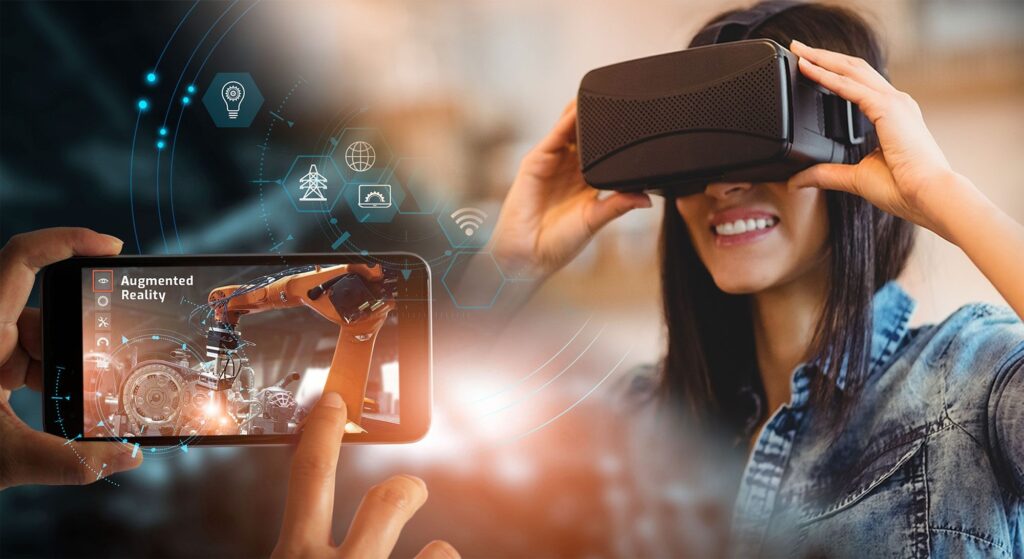
What if your phone could help you try on clothes virtually, guide you through a city with 3D arrows, or even let you watch dinosaurs walk across your living room floor?
This isn’t science fiction — it’s Augmented Reality (AR). Once confined to experimental labs and futuristic films, AR is now a part of everyday life, quietly transforming industries, enhancing user experiences, and redefining the way we interact with the world around us.
In this article, we’ll break down what AR is, how it works, where it’s being used today, and why it’s quickly becoming one of the most exciting and essential technologies of the 21st century.
What Is Augmented Reality (AR)?
At its core, Augmented Reality (AR) is a technology that overlays digital information—such as images, 3D models, text, and sounds—onto the real world in real time. It enriches your perception of reality rather than replacing it.
Unlike Virtual Reality (VR), which immerses you in a completely digital environment, AR keeps you grounded in the real world but enhances it with computer-generated visuals that can move, respond, or interact with your physical surroundings.
Chances are, you’ve already used AR without realizing it. Remember the global Pokémon GO craze? Or the Snapchat filters that add sunglasses or dog ears to your face? Or IKEA’s app that shows you how a couch would look in your living room? All powered by AR.
How Does AR Actually Work?
The magic of AR is made possible through a combination of key technologies:
- Cameras and Sensors: These capture your environment and help the system understand surfaces, objects, and depth.
- Processors: These analyze the real-world input and determine what digital content should appear and how it should behave.
- Display Devices: These project the digital layer onto your real environment, most commonly through smartphones, AR glasses, or headsets.
Today, the most common form of AR is mobile AR, which works through AR-enabled apps on smartphones or tablets. As AR glasses and wearables become more mainstream, we’ll see a shift toward even more seamless integration.
Types of Augmented Reality
Not all AR is built the same. There are several distinct types, each serving different use cases:
1. Marker-Based AR
This uses visual cues—like QR codes or specific images—as triggers. When the app recognizes the marker, it displays relevant digital content over it.
2. Markerless AR (Location-Based)
This uses your device’s GPS, compass, or accelerometer to place digital content based on your geographic location. Think of it as location-aware AR.
3. Projection-Based AR
This involves projecting light onto physical surfaces and interacting with the reflection. It’s more experimental but used in futuristic interfaces and exhibitions.
4. Superimposition-Based AR
Here, AR replaces a portion of the real view with an augmented version. It’s often used in medical imaging or architectural visualization.
Benefits of Augmented Reality
AR is gaining popularity for good reason. It offers a host of benefits that cater to both businesses and users:
- Enhanced User Experience: AR transforms passive viewing into active interaction.
- Greater Engagement: Interactive, immersive content keeps users interested longer.
- Smarter Learning & Training: Realistic simulations help learners understand and retain information better.
- Informed Decision-Making: Virtual try-ons and previews reduce guesswork, increasing consumer confidence.
Challenges Facing AR Technology
Of course, no technology is without hurdles. Despite its immense potential, AR still faces several challenges:
- Hardware Barriers: Advanced AR headsets and glasses are often costly and bulky.
- Privacy Concerns: Many AR apps require camera and location access, raising questions about data security.
- Content Development Costs: High-quality AR experiences require skilled developers, designers, and 3D artists.
- User Perception: Many users still associate AR mainly with entertainment and haven’t explored its professional applications.
What’s Next for Augmented Reality?
As supporting technologies like 5G, AI, and wearable computing evolve, the future of AR looks incredibly promising.
We can expect AR to become:
- More immersive and intelligent, with content that adapts to user behavior
- Widely integrated in education, medicine, tourism, and smart cities
- A core component of the metaverse, blending our physical and digital lives
Major tech companies—Apple, Meta, Google, Microsoft—are investing billions into AR, signaling that we’re only scratching the surface of its potential.
Conclusion
Augmented Reality is no longer a futuristic concept — it’s a reality shaping our present and our future.
From education and retail to healthcare and entertainment, AR is redefining how we see and interact with the world. Whether you’re a business owner looking to create immersive experiences or a curious learner wanting to explore cutting-edge tech, now is the perfect time to dive into AR. The line between digital and physical is fading — and Augmented Reality is drawing the map to this exciting new frontier.





